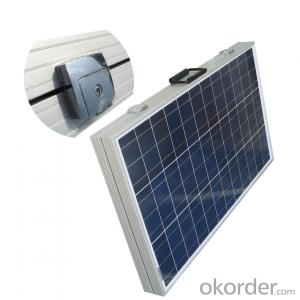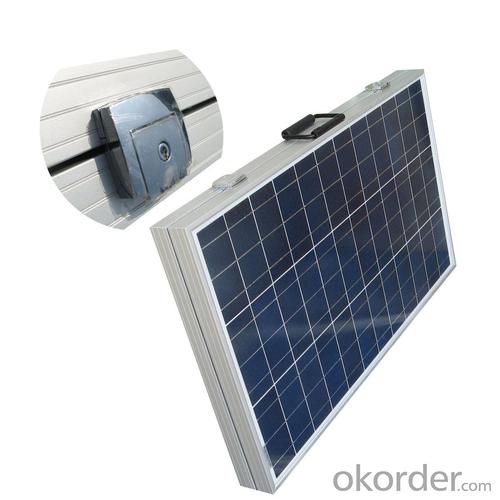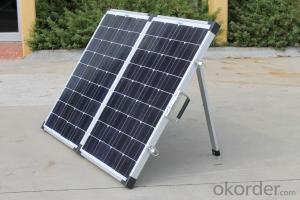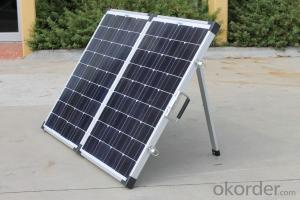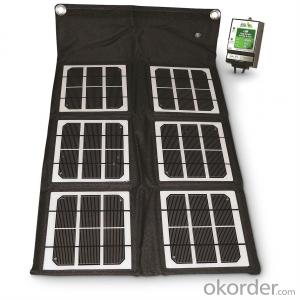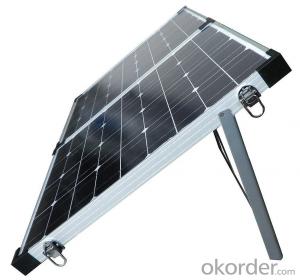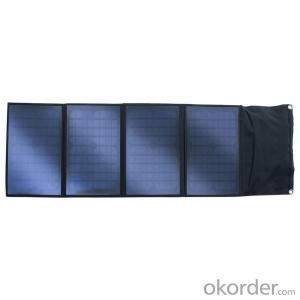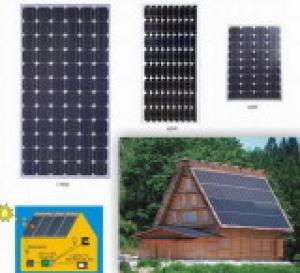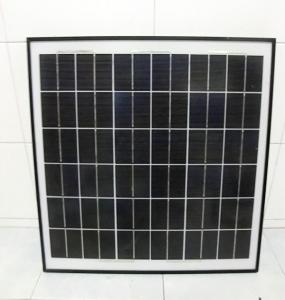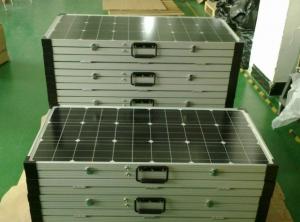Sells Solar Panels:130W Folding Solar Panel with Flexible Supporting Legs for Camping
- Loading Port:
- Shanghai
- Payment Terms:
- TT OR LC
- Min Order Qty:
- 1000 watt
- Supply Capability:
- 10000 watt/month
OKorder Service Pledge
OKorder Financial Service
You Might Also Like
Specification
Product Description
Folding module kits are designed to provide portable 12 volt power wherever you need it.PoPwer available from 20W to 240W
Features:
· Padded, moulded carry bag
· Heavy duty carry handle, hinges and clasps Stainless steel telescopic&adjustable legs
· Weatherproof solar charge controller with LED indicator
· 5m cable with heavy duty Anderson connectors between module-regulator & regulator-battery clamps
· All cabled up ready to use
· 2 year warranty
These kits are the ideal solution for 4WD, camping, caravaning, boating and recreational activities whereverpower is required for lights, small TV, camping fridge, pump or other small appliances.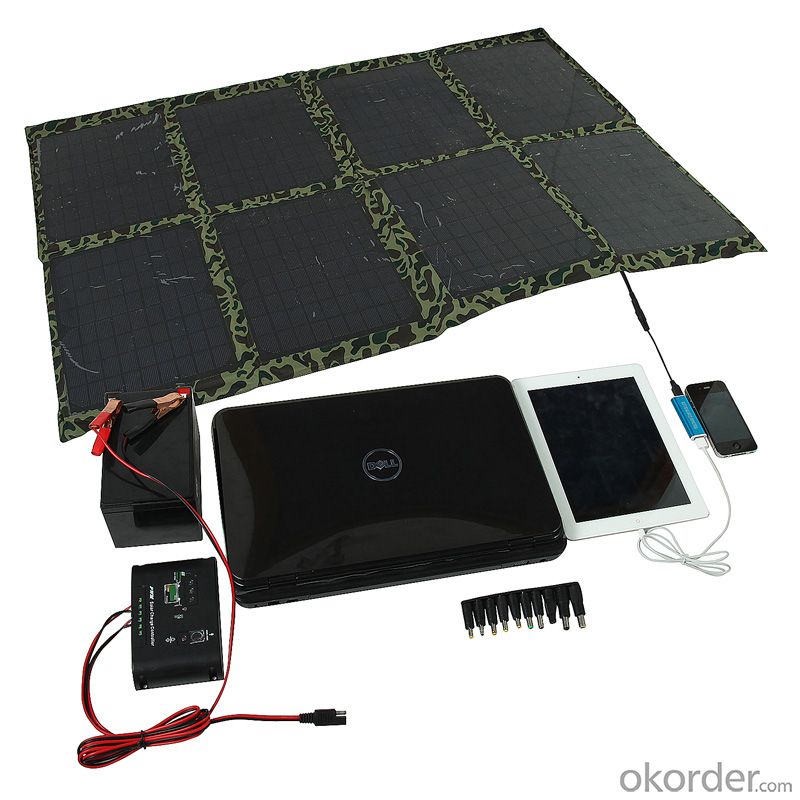
| Nominal Peak Power | 130W | 120W (2 x 60W) | 160W (2 x 80W) | 200W (2 x 100W) |
| Power tolerance | 3% | |||
| Cell type | Monocrystalline/Polycrystalline | |||
| Open circuit voltage (Voc) | 21.6V | |||
| Voltage at maximum power (Vmp) | 17.6V | 17.5V | 17.5V | 17.5V |
| Short circuit current (Isc) | 4.9A | 7.4A | 9.88A | 12.34A |
| Current at maximum power (Imp) | 4.54A | 6.86A | 9.14A | 11.42A |
| Maximum system voltage | 1000VDC | |||
| NOCT (Nominal Operating Cell Temperature) | 45 C +/-2 C | |||
| Operating temperature - module | -40 C to +85 C | |||
| Operating temperature – charge | -35 C to +55 C | |||
| Module folded size (mm) in carry bag | 505x550x60 | 505x825x80 | 505x1005x70 | 670x1005x70 |
| Module open size (mm) | 1014x550x30 | 1014x825x35 | 1014x1005x35 | 1344x1005x35 |
| Module net weight (kg) | 9.2 | 13 | 15.2 | 19 |
| Module gross weight (kg) | 11 | 16 | 19.4 | 23.2 |
| Solar charge controller | PWM 12V 10A; IP65 rated | PWM 12V 20A; IP65 rated | ||
- Q: I'm thinking of these solar panels that people have on their rooftops in domestic properties. I suppose I mean after how long do you break even with respect to just carrying on without them and getting you electricity from the utilities companies? Or answer in any way you think is pertinent. The more info the better.
- It's generally stated that it takes 0 years for them to pay for themselves. But the concept of paying for themselves is a primitive concept used by those who do not understand finances. You're still losing money when it pays for itself. A more appropriate analysis would be the Internal Rate of Return calculations, Excel makes this calculation easy. Overall,?solar power?is expensive power and works out about 38 cents per kwh ( proper economic estimates typically place it between 23 cents to 45 cents per kwh ). Some idiot here will insist solar doesn't cost that much per kwh, it does unless you're uneducated in finance. Note, it's also not clear if the energy produced by?solar panels?exceeds the energy required for their manufacture, delivery and installation. It takes a lot of energy to melt silicon and the costs triple if you try to recycle the toxic wastes which is why the panels are made where it's still possible to dispose of the toxic wastes. They could very well be causing more environmental damage then they save. With the Europeans what happens is the feed in tariffs makes the solar panels worthwhile. They still don't really pay for themselves but they allow you to take some of the tax money from your neighbors, a bit of an ethical dilemma really but ethics never stopped Europeans.
- Q: Hi there. I live in Colorado, and we obviously get a ton of snow there. I im looking into a solar power system for my home, and I am wondering if the snow will accumulate on the panels, or if, because of the energy passing through, it will melt on contact? By the way we get about 20' of snow each year, and it comes on often. I will also be putting them on my roof. Thanks for your help.
- Good news and not so good news. You need to be able to access the panels to clean the snow off. There is not any heat generated other than the heat of the sun hitting the black colour - which would amount to some melting ability during a sunny day - but it isn't sunny when it snows! Apparently, solar panels work better in the cold and where snow can reflect light so to increase the amount of light - photons - hitting the panel.
- Q: I want to know how to hook up a Solartech SPM020P-R, 20W Solar Panel to a single outlet that you can but at a store.
- That panel you reference puts out about 20W. @ 8V of DC. You can't wire that to a standard 20V outlet without a battery/inverter unit. Even then, you don't get a useful amount of power. In a full day you would collect enough energy to run a small TV for about an hour.
- Q: I have a home made 24 volt electric cart. It is powered by two 2Volt deep cycle batteries. Since the motor runs on 24 volts the batteries are wired in series to produce the 24 volts. I only have a 2 volt battery charger, but I also have two 2 volt solar panels. It is a pain having to unhook wires, rewire it, or charge them one at the time.HERE IS THE QUESTION REALLY... Can I wire the two 2 volt solar panels together in series (ie: negative to positive) then connect it to the existing 24 volt system and have it charge the batteries fine. I know basic wiring, but I know nearly nothing about solar panels, will it work fine? will it cause them to break? or short out?(additional info, the solar panels are only rated at 5 amps so it will not overcharge the batteries or anything)
- Wiring the panels in series should be ok as long as they are exactly the same. Different impedance's could damage the panels. Remember that Voltages and Amperage's are indirectly proportional meaning that if you series your panels your voltage will rise but the amperage will be reduced.
- Q: Do solar panels require regular cleaning?
- Yes, solar panels do require regular cleaning to ensure optimal performance. Dust, dirt, and other debris can accumulate on the surface of the panels over time, blocking sunlight and reducing their efficiency. Regular cleaning helps to remove these obstructions and maximize the energy output of the solar panels.
- Q: Polycrystalline solar panels are good or single crystal solar energy is good
- From the cost of production, than the monocrystalline silicon solar cells to be cheaper, easy to manufacture materials, saving power consumption, the total cost of production is low, so get a lot of development. In addition, the polysilicon solar cell life than monocrystalline silicon solar cells shorter. From the performance and price ratio, monocrystalline silicon solar cells also slightly better.
- Q: Currently being sold today! I know SunPower corp. commercial panels are about 20%.
- There are a lot of solar panels available today's. The problem of the efficiency is the proccess of converting, these cells use the photons of the sun to react with the ( Si compound inside the cell) due to the little thing that cell's are only a fraction of these energy is converted, remember that solar cells are paper thin and the really problem of these cells are the voltage not the amps. A single 3x6 inches solar cells can produce 3.6 amps but only 0.5 volts.
- Q: Can solar panels be installed on a warehouse or storage facility?
- Yes, solar panels can be installed on a warehouse or storage facility. In fact, warehouses and storage facilities are often ideal locations for solar panel installations due to their large, flat rooftops and ample space for arrays. Installing solar panels can help these facilities reduce their electricity bills, lower their carbon footprint, and even generate additional income through various incentive programs.
- Q: I can't figure out how to charge a Ni Cd (BD 8V Firestorm) battery directly with a solar panel so I've come up with an alternative which might or might not work. I thought I would connect an inverter (I found a nice 400W for $30) to my trucks battery and plug the BD Firestorm battery charger into the inverter. Then I was thinking I could use a 5W solar panel to trickle charge the truck battery and keep it connected after the Ni Cd is charged to ensure the truck battery is topped off. The truck would not be running during this process. Will this solution work? Is there a better solution?
- image voltaic charger employs image voltaic ability to offer electricity to units or cost batteries. they're oftentimes portable. image voltaic array: electric powered gadget alongside with an excellent array of related image voltaic cells image voltaic Panel is a crew of image voltaic cells arranged right into a panel which would be put in onto a flat floor. The panel captures image voltaic and converts it into DC ability.
- Q: I am planning to buy some solar panels for my cabin and i want to be able to store the electricity. what kind of batteries should i get? i will be running simple things like a tv and radio. where can i buy these batteries? where should i look for the best batteries?
- Deep cycle, Golf Cart Batteries. You can get them at a battery store.
Send your message to us
Sells Solar Panels:130W Folding Solar Panel with Flexible Supporting Legs for Camping
- Loading Port:
- Shanghai
- Payment Terms:
- TT OR LC
- Min Order Qty:
- 1000 watt
- Supply Capability:
- 10000 watt/month
OKorder Service Pledge
OKorder Financial Service
Similar products
Hot products
Hot Searches
Related keywords
